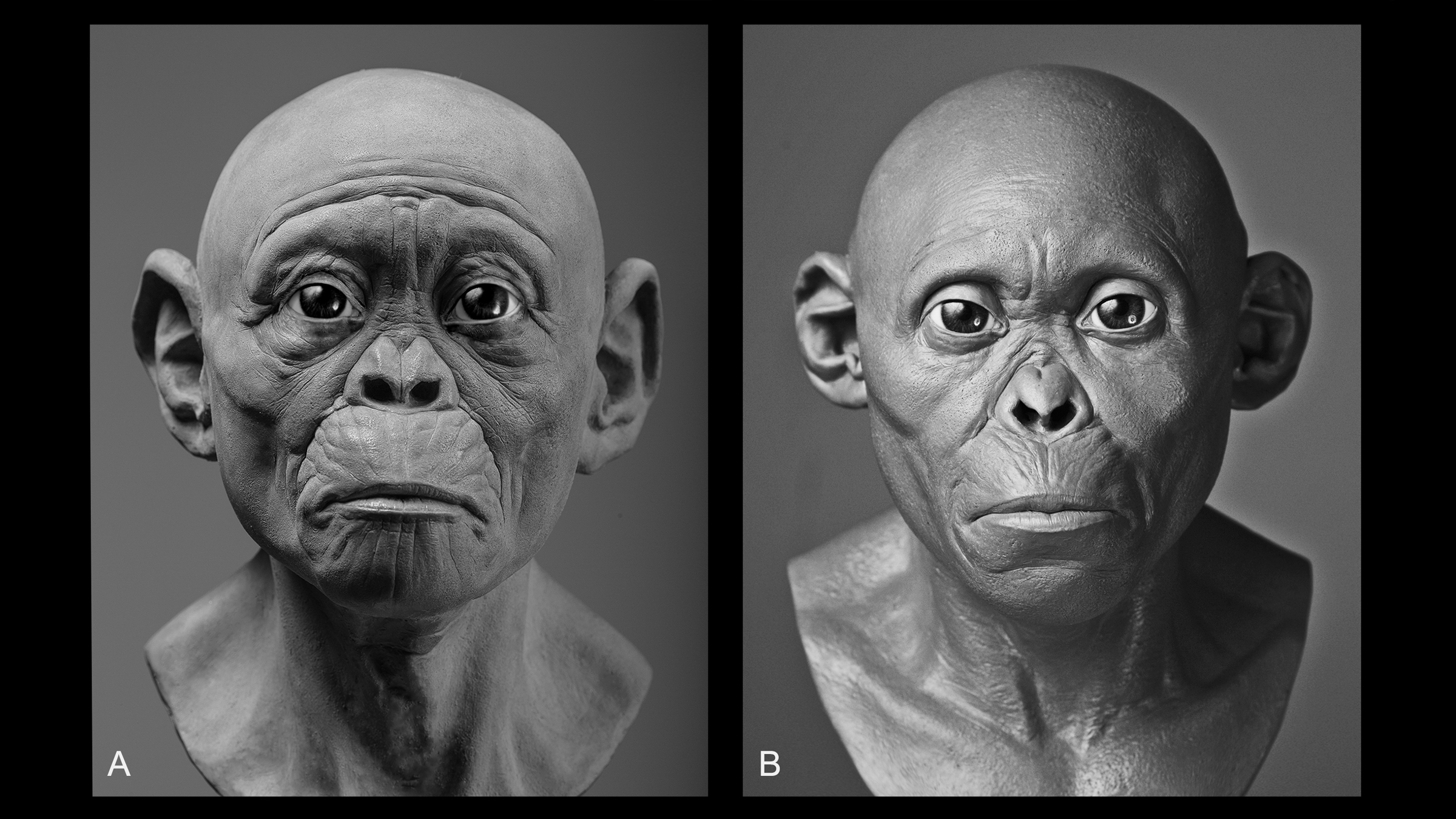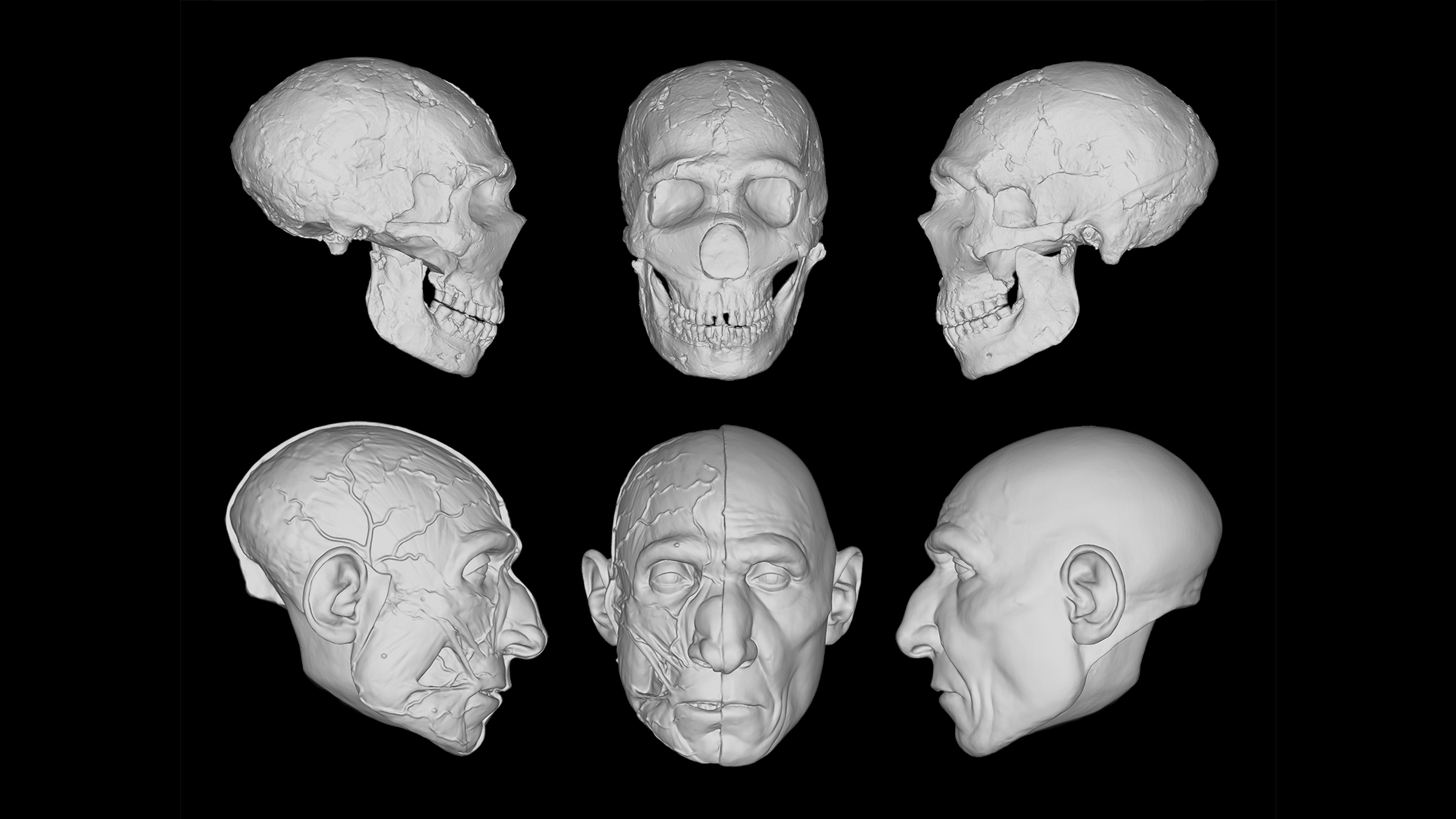Human ancestor 'Lucy' gets a new face in stunning reconstruction
Early human reconstructions tend to be more art than science.

New facial reconstructions of two early humans, famously known as Lucy and the Taung child, show how these two individuals may have looked when they lived in Africa millions of years ago.
And unlike past reconstructions, which may have relied on opaque, arbitrary or even racist ideas to reconstruct the faces of our ancient relatives, the authors of the new reconstructions lay out their process transparently.
For the reconstructions, of Lucy (Australopithecus afarensis), the oldest and most complete human ancestor when researchers discovered her 3.2 million-year-old remains in 1974, and the 2.8 million-year-old Taung child (Australopithecus africanus), who died at age 3 in what is now South Africa, researchers used pigmented silicone casts, with Lucy's skin tone similar to that of a bonobo (Pan paniscus), while the Taung child's features were more similar to modern humans native to South Africa, researchers wrote in a blog post.
These casts show just how complex reconstructions of early humans are. Other reconstructions of Lucy, the Taung child and other early humans were made by artists who made assumptions that aren't testable with current science, including whether these ancient species looked more like apes or modern humans, and how their soft tissues, including their muscles and the thickness of their skin, appeared. These reconstructions are often found in natural history museums and are meant to educate the public about human evolution.
Related: Photos: See the ancient faces of a man-bun wearing bloke and a Neanderthal woman
In a new review on reconstructions of early humans, published Feb. 26 in the journal Frontiers in Ecology and Evolution, the researchers, who also wrote the blog post, found that many reconstructions "have been largely unchallenged by the scientific community and displayed in museums with very little empirical evidence to support them," they wrote in the blog post.
When they looked at depictions around the world, they found that every museum's version of Lucy looked very different, review lead researcher Ryan Campbell, a doctoral student in the Department of Anatomy & Pathology at the University of Adelaide in Australia, wrote in the blog. "I expected to find consistency in those reconstructions displayed in natural history museums, but the differences, even there, were so severe that I almost thought all previous practitioners had never encountered a single hominid reconstruction before commencing their own."
Get the world’s most fascinating discoveries delivered straight to your inbox.
A previous analysis of reconstructions of 860 hominins (a group including humans, monkeys and their extinct close relatives) from 55 museum displays showed remarkable inconsistencies, even those depicting the same individuals. That research, part of a thesis published in 2012, was the first to show such discrepancies, Campbell and his colleagues wrote in their review paper.
Next steps
So, what's to be done? First, artists, scientists and museums may want to acknowledge that reconstruction is currently more art than science. According to review co-researcher Gabriel Vinas, a sculptural artist at Arizona State University, "methods for achieving scientifically justified reconstructions are still not quite in our grasp, despite what many artists and institutions readily advertise," he wrote in the blog.
Another problem is that some reconstructions, including 2D ones, and their exhibits are racist or inaccurate, the researchers said. "Actually, many of the previous reconstructions have been highly influenced by imaginary tales about what is 'primitive' and 'savage,' versus what is 'civilized and 'modern,'" review senior researcher Rui Diogo, an assistant professor of anatomy at Howard University in Washington, D.C., wrote in the blog.
For example, the iconic 2D image of human evolution, Rudolph Zallinger's "The March of Progress," printed in a series of science books in 1965, perpetuates the incorrect idea that humans evolved in a linear progression from animal to ape to a European-looking white-skinned man, the researchers wrote in the review. Other inaccuracies found in drawings or exhibits show Lucy with a mate and children, even though the nuclear family structure is a recent construction in human history, Diogo said.
In reconstructing the faces of Lucy and the Taung child, the researchers tried their best to "move away from intuition," and instead be scientifically accurate and transparent in their methods, they wrote in the review. For the Taung child, they used traditional molding and casting techniques to make a duplicate skull from another cast of the original specimen (commercially available casts weren't as accurate, they said). The Taung child's skull was well preserved, but they still had to make assumptions about how to design its facial tissues.
Because soft tissues from early humans haven't survived, artists have to decide whether to base muscles, skin and other soft tissue dimensions on data from primates like apes, chimpanzees or humans, or a mixture of species. For example, while reconstructing the Taung child, the team created two reconstructions — one more apelike and the other more humanlike to show the difference between the two interpretations. Other practitioners should clearly communicate their techniques, too, the researchers said.

Lucy's reconstruction, meanwhile, was a challenge. Even though she's the most reconstructed early human ancestor, Lucy "is a poor candidate for the facial reconstruction procedure because most of Lucy’s cranial bones are missing," the researchers wrote in the study. But her lower jawbone is fairly complete, so that helped the artists recreate her head.
For Lucy, the team used data on modern humans skin thickness, and plugged them into equations designed to determine early human skin thickness. But even though the result may be perceived as better than Lucy reconstructions that relied on more intuitive approaches, "we believe that this is not at all the case," the researchers wrote in the study. That's because the equation they used sometimes gave negative results, which isn't possible (an animal can't have negative tissue thickness). "Thus, these equations are perhaps only appropriate for reconstructing hominins" that look more like modern humans, the researchers wrote in the study.

A reconstruction of a Neanderthal specimen, known as Amud 1, was easier, as Neanderthals — compared with Lucy’s group — had more facial similarities with modern humans. However, the team had to estimate, based on other datasets, how to situate other features, such as the Neanderthal's nose profile and mouth width.


Going forward, scientists, artists and museums may want to remember that "presenting information that is not known diminishes the value of that which is known, and may lead to confusion and discourage further interest in human evolutionary theory," the researchers wrote in the study.
Originally published on Live Science.

Laura is the managing editor at Live Science. She also runs the archaeology section and the Life's Little Mysteries series. Her work has appeared in The New York Times, Scholastic, Popular Science and Spectrum, a site on autism research. She has won multiple awards from the Society of Professional Journalists and the Washington Newspaper Publishers Association for her reporting at a weekly newspaper near Seattle. Laura holds a bachelor's degree in English literature and psychology from Washington University in St. Louis and a master's degree in science writing from NYU.


